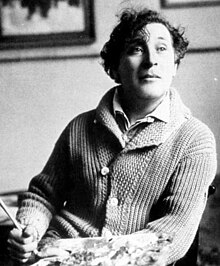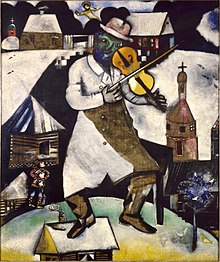Marc Chagall (夏卡尔) was a Russian painter of Jewish origin. He was born on July 7, 1887, Moishe Zakharovich Shagaloy inVitebsk, Belarus, Russia. In 1932 he moved to France. He was one of the most important artists of surrealism, and in his works can be seen the resonance of fantasy and dreams.
He was the oldest of nine children in the close-knit Jewish family led by his father, a herring merchant Khatskl (Zakhar) Shagal. This period of his life, described as happy though impoverished, appears in references throughout Chagall's work. He studied painting in 1906 under famed local artist Yehuda (Yudl) Pen and moved to St. Petersburg in 1907 to join the school of the Society of Art Supporters. There he studied under Nikolai Roerich. From 1908-1910 he studied under Leon Bakst at Zvantseva's School.
After becoming known as an artist, he left St. Petersburg to join the gathering of artists in the Montparnasse Quarter of Paris, France. In 1914, he returned to Vitebsk and married his fiancée, Bella. World War I erupted while Chagall was in Russia. Chagall became an active participant in the Russian Revolution of 1917. The Soviet Ministry of Culture made him a Commissar of Art for the Vitebsk region, where he founded an art school. He did not fare well politically under the Soviet system. He and his wife moved to Moscow in 1920 and back to Paris in 1923.With the German Nazi occupation of France during World War II, and the deportation of Jews to the Nazis death camps Marc Chagall had to flee from France. With the assistance of the American journalist Varian Fry he hid at Villa Air-Bel in Marseilles before Fry helped him escape from France. In 1941, the Chagalls settled in the USA. 1944, his wife Bella, the constant subject of his paintings and companion of his life, died from an illness.
He worked with Virginia Haggard through intense years and rediscovered a free and vibrant color. His works of this period are dedicated to love and the joy of life, with curved, sinuous figures. He also began to work in sculpture, ceramics, and stained glass. Chagall remarried in 1952 to Valentina Brodsky. He traveled several times to Greece, and in 1957 visited Israel.
Major works include "I and the Village" (1911), "Green Violinist" (1923-24, Guggenheim Museum, New York), "The Birthday" (1915), "Solitude" (1933, Tel-Aviv Museum). Today, a Chagall painting can sell for more than US$6 million. His work can be found in the Paris Opera, First National Bank Plaza of downtown Chicago, New York Metropolitan Opera House, cathedral of Metz France, and a small church in Mainz.
He died on March 28, 1985 and is buried in the Saint Paul Town Cemetery, Saint-Paul de Vence (near Nice), France.
He was the oldest of nine children in the close-knit Jewish family led by his father, a herring merchant Khatskl (Zakhar) Shagal. This period of his life, described as happy though impoverished, appears in references throughout Chagall's work. He studied painting in 1906 under famed local artist Yehuda (Yudl) Pen and moved to St. Petersburg in 1907 to join the school of the Society of Art Supporters. There he studied under Nikolai Roerich. From 1908-1910 he studied under Leon Bakst at Zvantseva's School.
After becoming known as an artist, he left St. Petersburg to join the gathering of artists in the Montparnasse Quarter of Paris, France. In 1914, he returned to Vitebsk and married his fiancée, Bella. World War I erupted while Chagall was in Russia. Chagall became an active participant in the Russian Revolution of 1917. The Soviet Ministry of Culture made him a Commissar of Art for the Vitebsk region, where he founded an art school. He did not fare well politically under the Soviet system. He and his wife moved to Moscow in 1920 and back to Paris in 1923.With the German Nazi occupation of France during World War II, and the deportation of Jews to the Nazis death camps Marc Chagall had to flee from France. With the assistance of the American journalist Varian Fry he hid at Villa Air-Bel in Marseilles before Fry helped him escape from France. In 1941, the Chagalls settled in the USA. 1944, his wife Bella, the constant subject of his paintings and companion of his life, died from an illness.
He worked with Virginia Haggard through intense years and rediscovered a free and vibrant color. His works of this period are dedicated to love and the joy of life, with curved, sinuous figures. He also began to work in sculpture, ceramics, and stained glass. Chagall remarried in 1952 to Valentina Brodsky. He traveled several times to Greece, and in 1957 visited Israel.
Major works include "I and the Village" (1911), "Green Violinist" (1923-24, Guggenheim Museum, New York), "The Birthday" (1915), "Solitude" (1933, Tel-Aviv Museum). Today, a Chagall painting can sell for more than US$6 million. His work can be found in the Paris Opera, First National Bank Plaza of downtown Chicago, New York Metropolitan Opera House, cathedral of Metz France, and a small church in Mainz.
He died on March 28, 1985 and is buried in the Saint Paul Town Cemetery, Saint-Paul de Vence (near Nice), France.
His painting styles are Expressionism and Cubism. In his paintings, he often painted violinists because he played the violin and also in memory of his uncle, who also played. He was also famous for his paintings of Russian-Jewish villages
 Photo taken 1921 in Paris | |
| Birth name | Moishe Shagal |
|---|---|
| Born | 7 July 1887 Liozna, near Vitebsk, Russian EmpireBelarus) (now in |
| Died | 28 March 1985 (aged 97) Saint-Paul, France |
| Nationality | Russian, later known as French |
| Field | Painting, stained glass |
| Movement | Surrealism, Expressionism |
| Works | see List of Chagall's artwork |
"The dignity of the artist lies in his duty of keeping awake the sense of wonder in the world. In this long vigil he often has to vary his methods of stimulation; but in this long vigil he is also himself striving against a continual tendency to sleep" - Marc Chagall
one of his famous work -
"I and the Village," painted in Paris in 1911
the art seems like relating a small fairy tale in a rural area, his native village precisely. It's portrays the artist's memories of Hasidic Community, a native community present outside Vitebsk. This painting is inspired by Marc's Jewish life and his Russian childhood. Reflecting his emotions well, "I and the Village" is truly non-imitable and can be described in many beautiful words. At first, this remarkable painting perplexes its viewers, owing to its superimposed images. Upon analysis however, it unfolds as a beautiful horizon of fantasy.
"The Fiddler" (1912)
The Birthday , 1915




Thank you for sharing this artists work. Noticed he uses a mixture of traditional judeo-christian symbols from the tree of life in his left hand, to the crucifix and the lamb. Would love to hear what impress you most about this artist.
ReplyDeleteThanx Alex... i think his painting is always full of colours and mixed a lot of fantasy! well, i guess, live for a hope! each of us, i believe have a song to sing about DREAMssssssssss
ReplyDelete